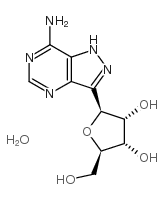The riddle of formycin A insulinotropic action.
W J Malaisse, P Lebrun, B Pirotte, P D Van Poelje, C Viñambres, M L Villanueva-Peñacarrillo, I Valverde, J Gäbel, P Rorsman
Index: Biochem. Mol. Med. 57(1) , 47-63, (1996)
Full Text: HTML
Abstract
Formycin A augments insulin release evoked by glucose (5.6 mm or more), this effect not being rapidly reversible. The mechanism responsible for the insulinotropic action of formycin A was investigated in isolated pancreatic islets. It could not be ascribed to facilitation of glucose metabolism. On the contrary, formycin A inhibited glucose oxidation, lowered ATP content, and impaired glucose-stimulated protein biosynthesis. The insulinotropic action of formycin A was apparently attributable to its conversion to formycin A 5'-triphosphate, both this process and the secretory response to formycin A being abolished by the inhibitor of adenosine kinase 5-iodotubercidin. In agreement with the latter view, adenosine receptor antagonists such as 8-cyclopentyl-1, 3-dipropylxanthine and 3,7-dimethyl-1-propargylxanthine failed to suppress and, instead, augmented the insulinotropic action of formycin A. Unexpectedly, however, formycin A failed to decrease 86Rb efflux, this coinciding with a low efficiency of formycin A 5'-triphosphate to inhibit KATP-channel activity in excised membranes and with the fact that formycin A increased gliben-clamide-stimulated insulin release. The secretory response to formycin A represented a Ca2+-dependent process suppressed in the absence of extracellular Ca2+ or presence of verapamil and associated with an increased net uptake of 45Ca. Nevertheless, the view that formycin A exerts any major effect upon intracellular Ca2+ redistribution, protein kinase C activity, or cyclic AMP net production also met with objections such as the minor secretory effect of formycin A in islets exposed to a high concentration of K+ in the presence of a diazoxide analog, the resistance of formycin A insulinotropic action to bisindolylmaleimide, the poor increase of cyclic AMP content in formycin A-stimulated islets, and the pronounced enhancement by forskolin or theophylline of insulin release from islets exposed to formycin A. It is concluded, therefore, that the mechanism of action of formycin A in the pancreatic beta-cell remains to be elucidated.
Related Compounds
| Structure | Name/CAS No. | Molecular Formula | Articles |
|---|---|---|---|
 |
formycin A
CAS:6742-12-7 |
C10H13N5O4 |
|
Purine nucleoside metabolism in the erythrocytes of patients...
1976-04-01 [J. Clin. Invest. 57(4) , 1025-35, (1976)] |
|
Tautomerism of the nucleoside antibiotic formycin, as studie...
1973-07-11 [J. Am. Chem. Soc. 95(14) , 4761-2, (1973)] |
|
Discovery of novel ribonucleoside analogs with activity agai...
2014-01-01 [J. Virol. 88(1) , 354-63, (2014)] |
|
Formycins A and B and some analogues: selective inhibitors o...
1992-04-17 [Biochim. Biophys. Acta 1120(3) , 239-47, (1992)] |
|
Structure of Escherichia coli 5'-methylthioadenosine/ S-aden...
2003-03-07 [J. Biol. Chem. 278(10) , 8761-70, (2003)] |